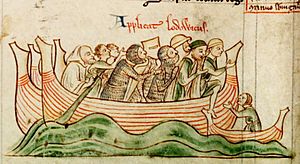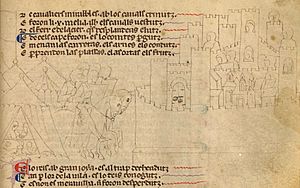Louis VIII of France facts for kids
Quick facts for kids Louis VIII |
|
|---|---|

Louis VIII's seal
|
|
| King of France (more…) | |
| Reign | 14 July 1223 – 8 November 1226 |
| Coronation | 6 August 1223, Reims Cathedral |
| Predecessor | Philip II |
| Successor | Louis IX |
| King of England (disputed) | |
| Reign | 2 June 1216 – 20 September 1217 |
| Predecessor | John I |
| Successor | Henry III |
| Born | 5 September 1187 Paris, France |
| Died | 8 November 1226 (aged 39) Château de Montpensier, France |
| Burial | Saint Denis Basilica |
| Spouse | |
| Issue more... |
Louis IX, King of France Robert I, Count of Artois Alphonse, Count of Poitiers Saint Isabelle Charles I, King of Sicily |
| House | Capet |
| Father | Philip II of France |
| Mother | Isabelle of Hainaut |
Louis VIII (born 5 September 1187 – died 8 November 1226) was known as The Lion. He was the King of France from 1223 to 1226. For a short time, from 1216 to 1217, he also claimed to be the King of England. Louis was the only son of King Philip II of France and his first wife, Isabelle of Hainaut.
Even though Louis VIII ruled France for only a short time, he was a very active leader before he became king. He helped his father, Philip II, stop an invasion by other European countries. This happened during the siege of Roche-au-Moine in 1214. Later, during the First Barons' War against King John of England, Louis sailed to England with an army. This was in June 1216, even though his father and the Pope did not want him to go. He took control of Winchester and soon had power over more than half of England.
The English barons who were fighting King John called Louis "King of England" in London in June 1216. However, he was never officially crowned. He gave up his claim to the English throne after the Pope removed him from the Church. He was also pushed back by the English after King John died. Louis then successfully took over Guyenne in 1217. This left the kings of England with only the region of Gascony in mainland Europe.
Louis's short time as king of France was important. He used his royal army to join the Albigensian Crusade in southern France. This helped bring the conflict to an end. He was also the first French king from the Capetian family to give large land areas, called appanages, to his younger sons. He died in 1226 and his son, Louis IX, became the next king.
Contents
Prince Louis: Early Life and Actions
Marriage and Family Life
In 1195, there was a plan for Louis to marry Eleanor of Brittany. She was the niece of Richard I of England. This marriage was meant to create an alliance between France and England. However, the plan did not work out.
On 23 May 1200, when Louis was 12 years old, he married Blanche of Castile. She was the daughter of King Alfonso VIII of Castile. This marriage happened after long talks between King Philip II of France and Blanche's uncle, King John of England.
Fighting in the 1214 Campaign
In 1214, King John of England tried one last time to take back the Duchy of Normandy from Philip II. King John had made alliances with powerful leaders like the Holy Roman Emperor Otto IV. John's plan was to divide Philip's army. John would attack from the south, while his allies attacked from the north.
King Philip II led the fight in the north. He put his son, Prince Louis, in charge of the fight against King John in central France. At first, King John did well, taking back the county of Anjou. John then surrounded the important castle of Roche-au-Moine. This forced Louis to fight against John's larger army. However, the local nobles refused to help King John, so he had to retreat. Soon after, Philip won the important Battle of Bouvines in the north. This ended King John's hopes of getting Normandy back.
Claiming the English Throne

In 1215, English nobles rebelled against the unpopular King John. This was called the First Barons' War. The barons offered the English throne to Prince Louis. On 21 May 1216, Louis landed in England with his army. He faced little resistance when he entered London. He was declared King Louis I of England at Old St Paul's Cathedral. Many nobles, and even the King of Scotland, supported him.
By June 1216, Louis had captured Winchester and controlled more than half of England. But when King John died in October 1216, many rebellious barons left Louis. They chose to support John's nine-year-old son, Henry III, instead.
With William Marshal leading as regent, the English fought back. Louis's army was defeated at the Battle of Lincoln in May 1217. His navy was also defeated at the Battle of Sandwich in August 1217. Louis was then forced to make peace with England. He also tried to capture Dover Castle but failed.
The peace agreement was called the Treaty of Lambeth. It offered forgiveness to the English rebels. Louis promised not to attack England again. He also received 10,000 marks (a type of money) from England. In return, Louis agreed that he had never been the true king of England.
Louis VIII: King of France

Louis VIII became king after his father died on 14 July 1223. His coronation ceremony took place on 6 August 1223 in the cathedral at Reims. As king, he continued to fight against the Plantagenet family (the English royal family). He took back the regions of Poitou and Saintonge for the French crown.
Rules on Money Lending
On 1 November 1223, King Louis VIII made a new rule. It said that his officials could not record debts owed to Jewish people. This changed the rules his father, Philip II, had set. At the time, lending money with interest was against Christian Church rules. However, Jewish people were not Christian, so some rulers allowed them to lend money. Louis VIII's new rule was an attempt to deal with this issue.
Twenty-six nobles agreed to this new rule. But Theobald IV, a powerful Count of Champagne, did not agree. He had an agreement with Jewish people that brought him extra money through taxes. Theobald IV became a strong opponent of Louis VIII's rule. For example, during the siege of Avignon, he only stayed for a short time and then left.
The Albigensian Crusade and Southern France

The Albigensian Crusade began in 1209. It was a war against the Cathars in southern France, especially in a region called Languedoc. At first, the northern French forces did well. But from 1215 to 1225, there were many local rebellions. These rebellions undid many of the earlier gains.
In 1225, a council decided to restart the crusade against the southern nobles. Louis was happy to renew the fight to strengthen his royal power. Roger Bernard the Great, a Count, tried to make peace. But the king refused his offer. So, the Counts of Foix and Toulouse fought against Louis.
Louis VIII led this new crusade. His army gathered in Bourges in May 1226. It was the largest army ever sent against the Cathars. They set out in June 1226. The Crusaders easily captured towns like Béziers, Carcassonne, Beaucaire, and Marseille. However, Avignon resisted. The city refused to open its gates to the French troops. Louis decided to surround the city in a siege. An attack in August was strongly pushed back. Finally, in early September, Avignon surrendered. The city agreed to pay a large sum of money and destroy its walls.
Death of King Louis VIII
While returning to Paris, King Louis VIII became sick with dysentery. He died on 8 November 1226 at the Château de Montpensier in Auvergne.
His tomb is located in the Saint Denis Basilica, just north of Paris. His son, Louis IX (who ruled from 1226–1270), became the next king. Queen Blanche, Louis VIII's wife, finished the crusade in the south in 1229.
Marriage and Children
On 23 May 1200, Louis married Blanche of Castile (born 4 March 1188 – died 26 November 1252). They had many children together. The most notable ones include:
- Louis IX (born 1214), who became King of France after his father.
- Robert (born 1216), who became the Count of Artois.
- Alphonse (born 1220), who became the Count of Poitou.
- Isabelle (born 1224), who later became a saint.
- Charles (born 1227, after his father's death), who became the Count of Anjou and King of Sicily.
Images for kids
See also
 In Spanish: Luis VIII de Francia para niños
In Spanish: Luis VIII de Francia para niños




